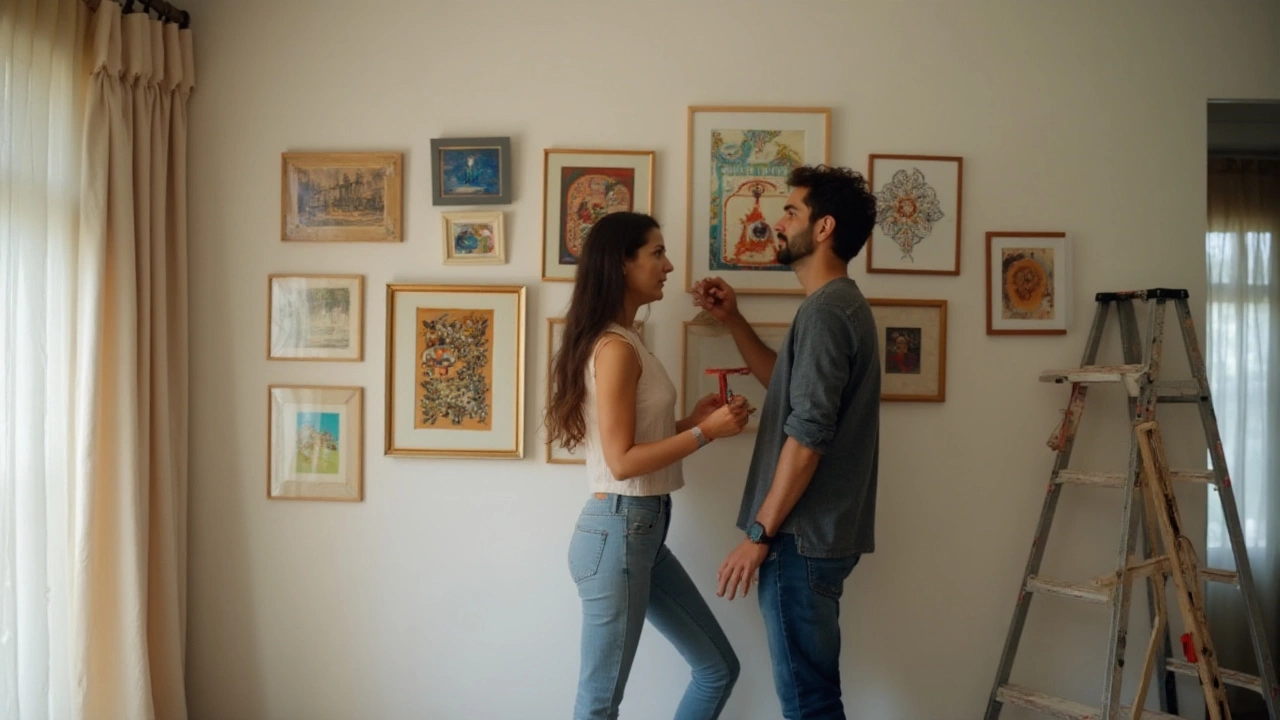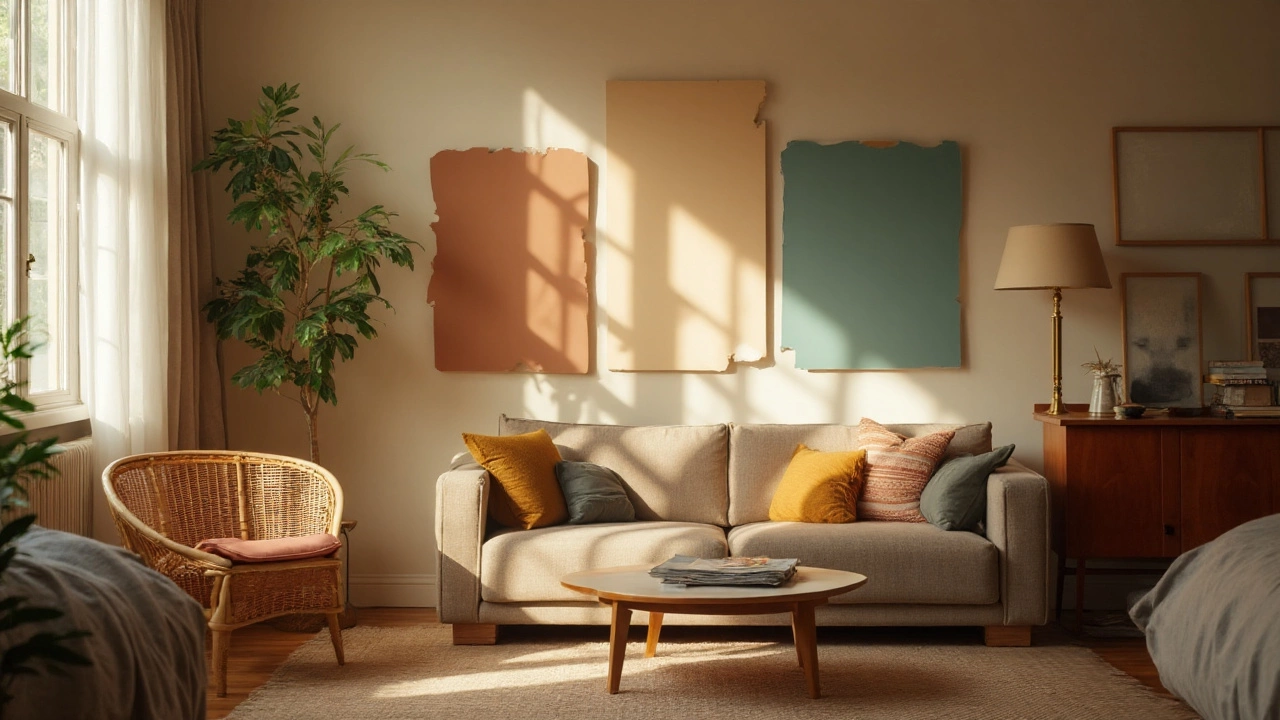Diving into the world of wall art can be an exciting adventure, where your walls become the canvas for your creative expression. Choosing the right art pieces means tapping into what speaks to you personally, whether it's vibrant paintings or minimalist sketches.
Once you've curated a selection, the layout becomes your playground. Arranging art is an art in itself, where balance and harmony transform a simple wall into a narrative.
When it's time to hang your art, you'll learn the importance of proper techniques—trust me, a well-placed nail can save a thousand sighs. Personalization doesn't stop there. Infusing unique elements and mementos can turn a mere arrangement into a storybook of memories and inspirations.
Choosing the Right Art Pieces
Venturing into the realm of wall art is akin to embarking on a journey of self-discovery. The selection process begins with understanding your preferences and the emotions you seek to evoke within your space. Consider starting by determining which art styles resonate with your personality. From abstract canvases that add a splash of unpredictability to serene landscapes that capture tranquility, your choice should reflect what speaks to you on a deeper level.
When choosing art pieces, the size of the work is crucial. Larger pieces can create a stunning focal point, often anchoring a room and drawing attention. On the other hand, smaller works or a collection of smaller items can tell a cohesive story when displayed together, often lending a sense of balance and harmony to a room. Experts often suggest starting with the largest wall art piece first, then layering smaller pieces around it for a cohesive look.
Understanding Art Styles and Themes
Understanding the variety of art styles available is a game changer. Traditional pieces lend a touch of elegance, whereas contemporary art can add a dynamic flair. If you're someone who enjoys a bit of history or nostalgia, vintage prints might be just your cup of tea. Whatever your style, make sure it aligns with the theme you want for your room. Whether it’s a vibrant, colorful theme or a minimalist, monochromatic one, consistency in your theme will help maintain coherence across your wall art.
Don't shy away from mixing different art styles if they harmonize well. For instance, juxtaposing a classic painting with a modern graphic print can create a unique, eclectic look. According to a study by the International Journal of Arts Education, mixing art styles in one’s living space can enhance creativity and reduce stress by providing a balanced visual stimulus.
“Art is not what you see, but what you make others see.” – Edgar Degas
Considering Color Schemes
The color palette of your home decor plays an integral role in art selection. A harmonious blend of wall art with existing room colors can give a sophisticated and unified look. Dive into color psychology to understand how certain hues can influence the ambiance of your room. Warm tones tend to evoke coziness, while cool tones offer calmness. Tables of color combinations can be a handy guide. For instance:
| Artwork Color | Room Ambiance |
|---|---|
| Bold Reds and Oranges | Energetic, Stimulating |
| Soft Blues and Greens | Relaxing, Inviting |
Choosing the right art pieces is more than just aesthetics; it's a pathway to creating spaces that are truly yours. The key is to select items that evoke the right mood and resonate personally with you, ensuring that your walls reflect the uniqueness of your journey.

Creating a Layout
Embarking on the journey to create a captivating layout for your wall art can be a delightful adventure. The first step in this process is understanding the space you're working with. Walls come in various shapes and sizes, and not all art layouts fit each scenario perfectly. Consider the dimensions of your wall and the furniture nearby, as they hugely influence the placement and spacing of your pieces. Ensuring that your layout is proportionate to the wall size helps maintain visual harmony. A gallery wall, for instance, can be a stunning approach if you have ample wall space. Conversely, a single large statement piece might work wonders in a smaller area. Use tape to outline potential arrangements on the wall to visualize your ideas before committing.
Next, think about the story you wish your art display to tell. Mixing different art styles or sticking to a singular theme can create varied effects. A cohesive collection of art tells a uniform story, maintaining consistency in color schemes and themes. Diverse styles can generate an eclectic vibe, offering dynamic diversity to your room. When experimenting with mixed styles, maintain a common thread, like a recurring color or theme, to tie the collection together. Don't hesitate to mix photographs with paintings or include textured pieces like textiles or 3D artwork for a more tactile feel.
You might find the golden ratio helpful here, a principle that often guides artists and designers. It’s about creating an arrangement that feels naturally pleasing to the eye. Balance and symmetry play pivotal roles here. Nonetheless, don't be afraid of asymmetry. Sometimes, placing a larger piece with smaller supporting pieces can create interest and draw attention. And when it comes to layout, think of the wall as a grid where you can place your pieces precisely, alternating between horizontal and vertical lines to keep things intriguing.
Once your preliminary layout plan is in place, remember the words of French painter Edgar Degas, who said,
"Art is not what you see, but what you make others see."Consider sightlines; align important pieces with eye level or slightly above for optimal viewing. This positioning respects the viewer’s perspective, making each piece more engaging. To further involve the viewer, you might also play with unexpected placements that encourage exploration and discovery.
In many homes, creating a layout is not only an aesthetic endeavor but also a practical one. Take lighting into account; natural and artificial lighting can dramatically alter the appearance of your home decor. Spotlights can emphasize certain pieces, enhancing their visibility and underscoring their importance within the arrangement. Be mindful of the effect of sunlight, which can fade artworks over time, and may necessitate choosing pieces that are less susceptible to such damage. Ultimately, planning your layout is akin to weaving a visual tapestry on your wall, inviting viewers to experience a bit of your world through art.

Hanging Techniques
To bring your wall art vision to life, nailing down—quite literally—the right hanging techniques is essential. It's not just about driving a nail and hoping for the best. The art of hanging requires a bit of precision and understanding. Begin by deciding the height at which you want to display your art. The rule of thumb is to hang art such that its center is at eye level, approximately 60 inches from the floor. This typical gallery standard creates a harmonious flow that’s pleasing to the eye and ensures artworks are not out of reach.
But let's dig in. Using tools like a laser level can be a game-changer, ensuring precision when lining up multiple frames. It saves you time and prevents those unsightly pencil marks. When working with multiple pieces, consider the spacing between each artwork. A gap of about three inches is often ideal—it allows each piece to breathe and be appreciated in its own right without overcrowding the wall. For heavier pieces, use a wall anchor to support the additional weight securely. You wouldn’t want your favorite piece of art crashing down unexpectedly.
"Good art arrangement is both an eye-catching display and a structural necessity," says Emily Henderson, a renowned home style expert.
Let’s not forget the importance of the layout before you commit to a hammer and nails. Laying your art pieces on the floor helps visualize the arrangement before it hits the wall. Use painter's tape to replicate the layout on the wall as a temporary guide. This method prevents the frustration of misalignments and multiple unnecessary holes in your wall. Consider different heights and alignments, such as grid or salon-style, which offer varied visual dynamics, depending on your personal taste and style of the room.
In terms of methodology, hanging systems have gained popularity. Picture rail systems are not only an elegant solution to avoiding direct damage to walls, but they also offer flexibility. This setup allows for easy adjustments or swaps of art without needing to alter the integrity of the wall surface. If you're someone who loves to change things up, this method proves invaluable in maintaining the wall's pristine condition.
If precision and ease are what you seek, exploring adhesive strips or hooks designed for art is worthwhile. They’re simple to use and do not damage walls—ideal for light to medium-weight art. As you gain confidence in hanging wall art, don’t shy away from experimenting. Whether it's creating an eclectic gallery wall or a themed collection, let your wall be a testament to your creativity and character.

Personalizing Your Space
Adding a personal touch to your wall art transforms your living space from just a house into a home that tells your unique story. Personalization goes beyond simply hanging a picture you like; it's about creating an environment that resonates with your life journey and interests. Start by considering the elements in your home that hold meaning to you—be it your travels, family heirlooms, or themes that pique your interest. By incorporating these into your wall art, you breathe life into static rooms.
One engaging method for personalizing your space involves integrating family photographs alongside traditional art pieces. This approach not only provides a window into your personal history but also creates a harmonious blend of intimacy and artistic value. Whether you choose a grid of frames or a more eclectic mix, the idea is to let your walls reflect your cherished moments. It’s fascinating to realize that when people step into your home, your walls speak for you, capturing their attention and sharing a piece of who you are.
Don't shy away from using art to reflect your passions. If you love literature, consider framing pages from classic novels or quotes that inspire you. Art related to hobbies, such as photography or music, can also find a place on your walls. For instance, a friend of mine, an avid music lover, framed a collection of vinyl covers, creating a stunning focus wall that sparks conversations. Such a display not only showcases your interests but makes the space distinctly yours. "Your home should tell the story of who you are, and be a collection of what you love," as Nate Berkus, noted interior designer, once said.
Another personal touch could be creating a gallery wall with an eclectic mix of frames and styles. Mix and match ornate frames with sleek modern designs for a dynamic look. The trick is to maintain a balance where each piece complements the others, leading to a cohesive display. And remember, personalizing is all about rules you set for yourself; hence, don't hesitate to rework the arrangement until each time you pass by, it brings a smile to your face.
You might also consider incorporating art created by local artists or pieces collected during your travels. This not only adds diversity and depth to your collection but supports artists who pour their stories into their artwork. Displaying such art can also offer unique insights into different cultures and epochs, enriching the narrative of your home's decor.
Lastly, why not use technology to your advantage? Digital frames are a modern solution that allows you to change the artwork you display at the click of a button. These can be especially useful for rotating through seasonal decor or showcasing recent family photos that hold special memories. With an ever-updating display, your space becomes dynamic and perpetually reflective of your current experiences and inspirations.




